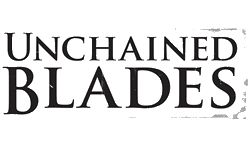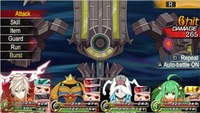|
|

|
PLATFORM
|
PSP
|
BATTLE SYSTEM
|

|
INTERACTION
|

|
ORIGINALITY
|

|
STORY
|

|
MUSIC & SOUND
|

|
VISUALS
|

|
CHALLENGE
|
Moderate
|
COMPLETION TIME
|
60-80 Hours
|
|
OVERALL

|
+ Exciting, versatile soundtrack.
+ Followers and the Skill Map jazz up battles.
- Too long for its pleasures.
- Limited characterization.
|
Click here for scoring definitions
|
|
|
Unchained Blades is a game of ideas. Some of them succeed, while others are notable just because they were tried. First-person dungeon crawlers like Wizardry are a tough sell for those who aren't already fans of the genre. They conjure images of identical corridors, unfair challenges, and game-bloating grinds. Unchained Blades addresses these problem with pleasant visuals, excellent music, and plenty of bells and whistles. The core experience of pushing through auto-mapped corridors and fighting random battles isn't especially different from its predecessors, but the subsystems and world design justify the game's existence. Whether they justify its 70-80 hours of playtime, plus the gargantuan postgame dungeon, is left as an exercise for the individual. Ultimately, it is difficult to deny the game offers the richest play experience to fans of lengthy dungeons and careful planning, to whom the sparse story is a secondary concern.
The core story concerns a group of human-monster hybrids with issues. All of them see the Titans of the Goddess Clunea as the best way to come to terms with their bodies and emotions. Anyone who defeats the dungeons housed in the gargantuan Titans earns a wish. This isn't a game for people who prefer to spend their fictional wishes on getting more wishes. The protagonists live in a world where anyone with the gumption to delve a few floors into a dungeon gets a free wish. Nevertheless, their wishes rarely work as intended. This isn't a negative critique of the story--that comes later--nevertheless, it's a warning to gamers who don't appreciate the common literary role of wishes.
Biology in the world of Unchained Blades is curious enough that it should receive further attention. All inhabitants start as hybrids of humans and monsters. For example, Tiana of the Phoenix Clan has orange and yellow wings and flaming red hair. Upon reaching adulthood, the human-monster hybrids transform into full-fledged monsters: Tiana's father is a giant bird who wears a necklace and crown. Wandering monsters, of the sort an average adventurer murders by the bushel, are adults who've given in to their selfish desires. This system allows for rich commentary on the generation gap and the erosion of youthful ideals. However, most of this material is left unexplored except for how it influences the character design.
 The bigger they are, the more they attack.
The bigger they are, the more they attack.
|
|
The main problem with Unchained Blades' plot is its spareness. Despite the lengthy playtime, the character arcs end too quickly. The party members have interesting problems and enough spark to make them likeable. However, most of the payoff feels unearned. Did the characters really learn a lesson from their experiences, or are they just saying they did? Where and when do the party members grow from strangers into the staunch comrades shown in the sole ending? This disconnect suggests conversations to which the player is never privy. On the other hand, this may be asking too much. Quiet protagonists and missing conversations are a genre staple, and it can be fun to imagine filler for the gaps. The characters have more personality than required by a dungeon crawler--especially if the core mechanics are fun.
Each of the Titans is shaped like a giant animal. This totem spirit influences the dungeon's background music, the floor maps, and many of its monsters. For example, the second Titan is a city-sized sea turtle. The background music sounds like being trapped in a soothing tropical sea cave. The dungeon begins in the belly of the beast (The Belly of Hatred) and ascends toward its shell (of Chaos.) Many of the monsters are water-themed, and much of the belly is given over to rising-water traps. Dungeon passages contort to fit the theme, where applicable. Leg-levels look like legs, arm-levels look like arms. Guts look especially gut-like, as the corridors are labyrinthine. Auto-map handles the heavy lifting here. Every step is accurately recorded in a transparent overlay in the upper-right corner of the screen. Accessing the full dungeon map requires the simple push of a button. The complete map interface provides access to every level mapped, a larger version of the mini-map icons, and a counter that tells how much of the floor is mapped.
Monster-hunting is Unchained Blades' most prevalent subsystem. Much like in a Shin Megami Tensei game, the player recruits monsters for use in battle. After capturing (or "unchaining") a monster with a timing-based minigame, characters can equip followers based on their Charisma scores. Between battles, monsters ask questions about life, the universe, and everything. Interacting with followers adds depth to combat, but has its hiccups. Many of the conversation options are oddly phrased or keyed to non-intuitive icons, resulting in responses that don't match the intended tone. It's unclear if this is an issue with the translation or the core engine; either way, it encourages careful note-taking for the warlord who hopes to raise a happy crop of followers.
Well-maintained forces of followers are especially satisfying against large forces. Random encounter battles aren't limited to a single screen of enemies, nor are boss battles. Oftentimes, there are so many enemies (or they're so large) that the shoulder buttons are necessary to take in everything wishing the player harm. Having so many willing shield carriers makes battles seem especially dynamic; in a sense, they encourage epic-looking clashes without requiring additional time grinding for experience. Although most of the bosses don't have the mechanical clout to back up their fearsome facades, they're always intimidating.
 A dragon emperor, phoenix girl, fox girl, and death girl walk into a dungeon...
A dragon emperor, phoenix girl, fox girl, and death girl walk into a dungeon...
|
|
Judgement Battles offer another way of shaking up standard combat. Here, followers take the center stage. During set points in the dungeons, the party's captured monsters skirmish with enemy forces via a rhythm game. These battles reinforce the necessity of keeping a powerful stable of followers: each Judgement Battle is more difficult than the last, so training followers and disposing of less useful ones is required to bypass these choke points. The rewards for Judgement Battles make them a worthwhile addition to the dungeoneering experience; moreover, they add texture to the standard issue hall-walking and switch-flipping.
Followers do more than fight; they also fuel the skill system. Each character has a Skill Map similar in design to Final Fantasy X's Sphere Grid. Every level, characters gain two Skill Points, which can be used to fill in bubbles on the Skill Map to gain skills and statistics. Each Skill Map contains multiple paths, allowing character configurations to suit players' individual styles. The most interesting skills on the Skill Map have elemental requirements such as Fire, Claw, and Dragon known as anima. Even after a character learns a skill, he or she can't use it until equipping followers with the proper anima. Unfortunately, there isn't any in-game indication about the rarity of each anima. As a result, some Skill Map configurations allow access to more usable skills than others. The game isn't so challenging that poor Skill Map allocation is an insurmountable challenge, and grinding provides more than enough Skill Points to complete the map. Nevertheless, this is one area where a play guide would be useful. Overall, juggling anima and continually replacing followers toes the line between tactically important decisions and lengthy micromanaging.
Although the micromanaging is imposing at first, it soon becomes second nature. Unfortunately, this shift signals the end of the challenge. The first two Titans are difficult, while the limited character options in the third Titan make it merely unbalanced. The game's overall challenge peaks in the terrible, terrible third chapter. After this point, the challenge never quite recovers until the postgame. Fortunately, auto-battle is quick and well-implemented.
Despite Unchained Blades' voice-acting pedigree (Troy Baker, Yuri Lowenthal), much of the work is unconvincing. Fang's unrepentant jerkiness and Clunea's furious arrogance are highlights. The rest of the voices range from oddly charming to forgettable. Licensing issues nixed the use of the Japanese voices, leaving listeners with little choice. However, the strong soundtrack by Tsutomu Narita (with brief appearances by Nobuo Uematsu) provide reason to keep the audio unmuted. The final boss music is especially effective at communicating the stakes of the battle.
After listening to Narita and Uematsu's unchained melodies and toppling the Titans, it's necessary to reflect. Unchained Blades isn't unenjoyable, and its subsystems are an inventive take on what less skilled hands would have turned into a bare slog. However, a game as long as this one needs something greater to keep the inevitable hours of filler at bay. Deeper, more nuanced characters would have been been one route. Alternately, a smoother difficulty curve would've limited the opportunities to switch on autopilot. FuRyu, the Japanese developer, hasn't been around for long, so the verdict remains out on their overall reputation. Entering Unchained Blades into the evidence suggests their fortunes can go either way.
Review Archives
|









